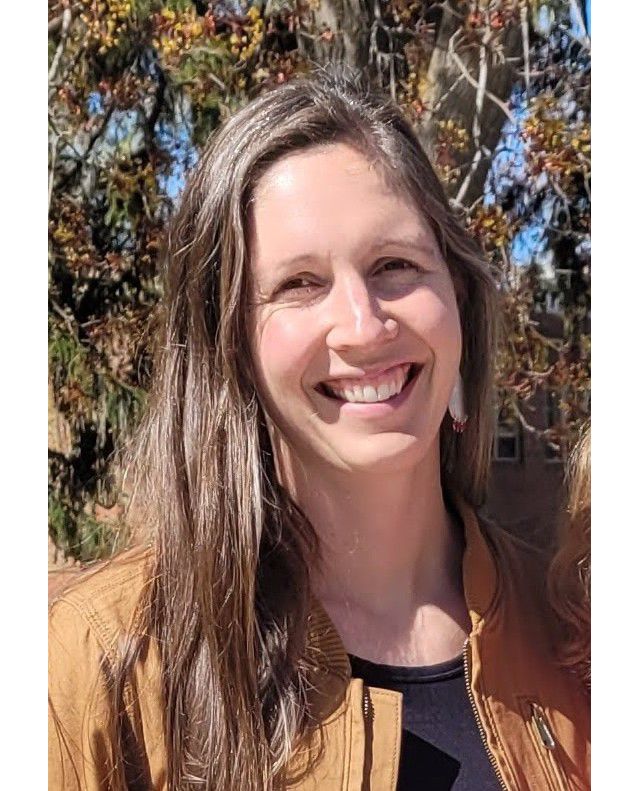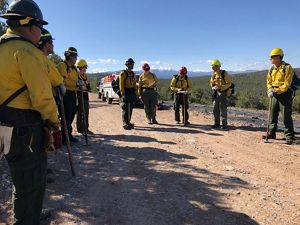Future Forests: Living with Fire
Honesty, Humility and Hope at a Taos Community Discussion
The 2024 wildfire season is underway, and New Mexico is on guard. As we hope for the best, we must be poised to protect communities and our natural and cultural resources. Experts statewide are also having new conversations around forest management, the prevention of mega-fires and how to keep people and nature safe and thriving.
“Fire is the greatest gift that has ever been given to Indigenous people—and to all people.” These words were spoken by Rene Romero, a veteran smokejumper and Taos Pueblo Forestry coordinator, as he joined a panel of experts at a special event hosted by The Nature Conservancy at the Harwood Museum of Art in Taos in September 2023. The gathering, called Future Forests: Living with Fire, was made possible by the generous support of the Taos Ski Valley Foundation.
In his comments, Romero reflected on how people have lost the connection they once had to nature and to its elements and cycles, such as fire. He noted that we’ve been taught “to fear fire,” and he urged New Mexico residents to reconsider this powerful paradigm. Romero’s sentiments touched on a theme that permeated this lively and important community discussion: fire plays a crucial role in ecosystem health, and we need to change how we manage our forests. And the time for this shift is now.

Setting the Scene
Matt Piccarello, TNC in New Mexico’s forest and watershed health manager, moderated the event’s panel discussion, and he also set the scene: we stand at a pivotal moment for New Mexico forests. For hundreds of years, periodic, low-intensity fires played a crucial role in keeping the state’s forests healthy, our soils intact and our watersheds functioning. But about a century ago, America began to alter this balance on a large scale. A nationwide policy of forest fire suppression coupled with poor forest management practices and the increasing effects of climate change have put our forests—and our communities—increasingly at risk. Dry forests are now overgrown with fuel that can cause larger, more intense and more dangerous wildfires.
Quote: Matt Piccarello
We stand at a pivotal moment for New Mexico forests....Can we learn to live with fire as a necessary ecological disturbance and to use it as a tool to keep our forests healthy?
The question today, Piccarello explained, is whether we can now adapt. Can we learn to live with fire as a necessary ecological disturbance and to use it as a tool to keep our forests healthy? He underlined the positives of the moment: never before have we had the diverse coordination, the science and technology and the funding to transform our relationship to fire management and forest restoration. Key federal legislation, including the Inflation Reduction Act and the Infrastructure Investment and Jobs Act, among others, have created unprecedented opportunities to fund critical work such as prescribed burns, thinning and replanting.

A Vision and a New Resource
Accentuating Piccarello’s point, the event’s next presenter, Rachel Foe, reforestation coordinator for NM Division of Forestry, highlighted an exciting new resource now under construction: the New Mexico Reforestation Center. The center, which is taking shape in Mora, New Mexico, will feature a state-of-the-art tree seedling nursery and will serve as a regional hub for forest health research and coordination.
Foe explained the key role this new center will play in restoring the forests that have been decimated by megafires. The need, she explained, is huge. “There are 133 million acres in need of reforestation across the United States,” she said. “And it would take 3 billion seeds a year to reforest all of that land.” The increasingly severe fires of the last century have left many burned areas that do not naturally regenerate. Without strategic, science-informed reforestation, these burned areas pose a threat to both humans and nature. Healthy forests play a huge role for New Mexico’s watersheds, capturing, filtering and retaining water. Without them, our water quality, supplies—and our communities—are at risk. “Forests supply 50% to 75% of all water used by municipalities and agriculture in New Mexico,” said Foe. The New Mexico Reforestation Center is set to be in operation by 2028 and has already set an ambitious vision of eventually producing 5 million seedlings per year (an exponential increase from the state’s current production of 300,000 seedlings per year).
Lessons Learned, Opportunities and Trust

After the introductory presentations from Piccarello and Foe, a panel of experts took to the stage for an hour-long Q&A session with the audience. What ensued was an open dialogue with some thoughtful questions and meaningful exchanges. In addition to Romero from Taos Pueblo (mentioned above), the panel also included: Mary Stuever, district forester for Cimmaron; JR Logan, forest and watershed health program manager for Taos County; and Brent Davidson, fuels and fire staff officer with Carson National Forest.
As the panelists fielded questions, a few key themes emerged. Those themes, and a few select responses from the panel members, are summarized below.
This is an incredibly complex issue.
The panel touched on how many different layers of complicated cultural, political and environmental histories and large-scale decisions are wrapped into the situation we find in our forests today. They also pointed out how intricate the science of fire, climate change, mitigation and reforestation can be when put into practice on the ground.
“We have to acknowledge the complexity. You have to consider the whole system. It’s complex to put fire on the ground…We need fires burning that are not threatening but instead doing the beneficial work we need them do to…Deciding where and how to replant is not black and white…Our big job is to pay attention to mother nature and take her cues.”
—Mary Steuver
Quote: Brent Davidson
Change is difficult.
Panel members acknowledged that there are many differing experiences and perspectives on wildfire, there are many diverse stakeholders who value and use forests in a range of ways, and there has often been a lack of collaboration and good communication around goals.
“Prescribed fire and thinning are the right thing to do….I feel that way strongly, but I also recognize that not everyone agrees. I understand that we may have one vision and goal when we thin a forest or burn an area, but to nearby community members it looks like we’ve taken a beautiful forest and ruined it. I think we have to have honest, non-patronizing conversations and build relationships so that people understand the future benefits. In the end, we all want the same things.”
—JR Logan
“We must accept that we can’t control nature the way we thought we could in the past.”
—Mary Steuver
Mistakes have been made. Trust is key.
Audience members and panel speakers agreed: with forest management, we are learning as we go, and we haven’t always gotten it right. People have been excluded. Prescribed burns have gone awry. Replanted trees have been misplaced. Federal policies do not always serve the right purposes.
“I do think that in the past, there was a tendency in the Forest Service to keep goals and problems internal. I do now see a culture shift, where we are sharing more, being more transparent with our partners, doing more collaboration. I think the policy changes and attitudes toward fire suppression are a big example of the Forest Service learning and evolving.”
—Brent Davidson
“Planting trees is not just putting a hole in the ground. You can do it poorly. Planting can be done wrong. Not only have we learned so much through the years that we can now apply, but we also now need to consider climate change and other issues complicating restoration. This is why the New Mexico Reforestation Center is so exciting. We have new tools to use and will consider all factors.”
—Matt Piccarello
“We still need to learn and change. We need to change the government’s outlook on Wilderness designation. We need the authority to manage and mitigate these ‘Wilderness’ forests that play a crucial role for the Taos watershed.”
—Rene Romero
Quote: JR Logan
I think we as a community need to step up and move past the paradigm where we point the finger.…We need to acknowledge there is a legacy of patronizing and excluding locals…but [the Forest Service] has had a major cultural shift. There’s a recognition of needing to seek a middle ground.
There is much to do, and now is our time.
Panel members stressed that we stand at a crossroads for forests in New Mexico. The threats have never been greater, but we also have historic opportunities for change, for impact, for teamwork and for funding.
“My big focus is to do things to try to keep that soil on the slope. The soil is a gift. It can take up to 10,000 years to produce one inch of soil. We are now having conversations to ensure we are putting the right tree in the right place. This is really exciting and a point of pride. We’re talking about how to grow a seedling that is strong and resilient. We’re talking about creating a microsite that will allow a tree to thrive.”
—Mary Steuver
“Do we have the workforce to do the mitigation and restoration work we need to do? Yes. But our restoration economy is still quite thin. We have to get more creative to create consistency for job seekers. New Mexico is taking a leadership role. There’s space for everyone at the table. We need to expand our horizons. There should be crews that do it all, but there aren’t yet. We need to cross-train so that we have the same crew burning, thinning and planting.”
—JR Logan
“We don’t have a choice. Today, living with fire is our reality. We’re going to have to find middle ground. We have to understand there will be inconveniences as we learn to better manage the landscape.”
—Brent Davidson
Quote: Matt Piccarello
We pulled fire out of a complex system, and now we’re seeing the negative effects. There are now billions of dollars in federal funding available. We need to meet this crucial moment in New Mexico—this work is going to happen—there is significant money going to on-the-ground projects.
All of us have a role.
The discussion ended with a question from an audience member about how local community members can get involved to support the protection and restoration of New Mexico’s forests. Panel members highlighted the need for private landowners to think and act creatively and for more people to be involved in outreach.
“When I talk with people, I try to convey that we can have some humility about the timeline of forests, and we can look past our own time. The fire did something that looked ugly at the moment, but it delivers the beauty of the forest in the future.”
—JR Logan
“Taos is home. This is about taking care of our home. Nature is way stronger than us; we cannot stop it…We can do better. Everybody can do better to address fire.”
—Rene Romero
The panel and TNC’s Matt Piccarello also shared several resources to help people learn more; check them out below. Stay tuned for more TNC New Mexico events in the future that bring together diverse thought leaders and offer community members the chance to explore conservation issues that matter to all of us.
We Can’t Save Nature Without You
Sign up to receive monthly conservation news and updates from New Mexico. Get a preview of New Mexico’s Nature News email.








